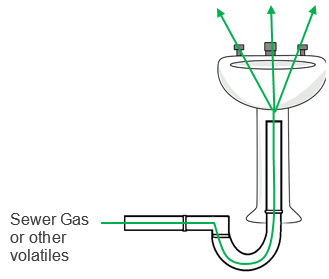What's that stink? It could be your drain.
February 13, 2020 - EHS Chemical Safety
Indoor air quality complaints can be caused by many problems. One common problem across Michigan State University is dry drains.
What is a dry drain and how does it happen?
Each drain is equipped with a trap that keeps sewer gases or other volatiles from being able to come back inside the room or building. The trap is filled with water that prevents gases from coming back up the drain. However, if a sink isn’t used for a while, water can evaporate from these traps and cause a dry drain. Once the drain is dry, sewer gas or vapors from improperly disposed chemicals can come up through the drain and cause an odor in a room.

Water has evaporated from the trap allowing the sewer gas to come up through the drain and cause an odor
How do I prevent or fix a dry drain from occurring?
The easiest solution to fix a dry drain is to simply re-fill the trap in the sink with more water. Prevent dry drains from occurring by running water in a drain at least every few months. This includes all drains even ones in fume hoods and on the floor. Hazardous waste must NOT be disposed of down the drain.

Normal sink trap filled with water prevents sewer gas from coming up drain
If this does not resolve the odor, please contact Environmental Health and Safety at EHS@MSU.EDU or call 517-355-0153.

